Celery is a commonly used vegetable that is widely recognized for its mild flavor and crunchy texture. However, not everyone is a fan of celery.
Some people don’t like its taste, while others may have an allergy to it.
Whatever the reason, we understand the struggle of finding the perfect celery substitute for your dish since celery is often used as a primary ingredient.
But don’t worry; we’ve got you covered! In this blog, we will discuss 10 ideal substitutes for celery, along with their ratios and how to use them in your cooking.
In short, " What can I use instead of celery?" Fennel, Bok Choy, Celeriac, Jicama, Leeks, Asparagus, Green Bell Peppers, Cucumber, Parsley, Zucchini.
What is celery, and what does celery taste like?
Celery is a crunchy and leafy vegetable that belongs to the Apiaceae family. It has long, pale green stalks with a ribbed texture and leafy tops.
The entire celery plant is edible, including the stalks, leaves, and seeds. It is widely used in culinary preparations and is known for its unique flavor and crisp texture.
The taste of celery is fresh, mildly sweet, and has a distinct earthy undertone. It is often defined as having a clean and refreshing flavor with a slight bitterness.
The stalks have a crisp and crunchy texture, while the leaves are more delicate and herbaceous in flavor.
Celery’s flavor is versatile and complements a wide range of dishes. It is normally used as a key ingredient in soups, salads, stir-fries, and vegetable juices.
Its subtle yet distinctive taste adds depth to recipes and provides a refreshing element to the overall flavor profile.
In addition to its culinary uses, celery is also valued for its nutritional benefits. It is lower in calories, high in fiber, and a fine source of vitamins and minerals.
The crunchy texture and refreshing taste of celery make it a popular choice for healthy snacks and a flavorful addition to various dishes.
Overall, celery offers a unique combination of freshness, mild sweetness, and a touch of bitterness. It’s crisp texture and distinct flavor make it a versatile ingredient in both raw and cooked preparations.
Uses of celery in cooking
Celery is a versatile vegetable, making it perfect for adding to salads or as an addition to other dishes like stir-fries and soups.
The crunchy stalk of celery is also great for scooping up dips and sauces as part of an appetizer platter.
The leaves can be diced up and added to meals as an aromatic herb, or they can be cooked down into soups and stews to add flavor.
Celery root, or celeriac, is also popular in cooking as it can be made into creamy purees or roasted in chunks to bring out its subtle sweetness.
When cooked, celery retains much of its flavor but with a softened texture that provides an interesting contrast with other ingredients in the dish.
It is often used in mirepoix – the French mixture of vegetables sautéed together that forms the base of many dishes such as soups, stews, and sauces – to give a sweet flavor alongside carrots and onions.
Gently sautéed celery adds depth to risottos or can be mixed into casseroles for extra flavor and texture.
Celery is also popularly used in quick pickles, which are made by combining equal parts vinegar, water and sugar with some salt before adding thin slices of celery and leaving them overnight or longer for deeper flavor.
Pickled celery can work well on sandwiches or salads or simply be eaten alone as a snack!
Where to buy celery?
If you are looking for celery where to buy, there are multiple places you can go. Many specialty food stores carry it, as do some international grocery stores.
You can also order online from many retailers that provide a variety of diverse flavors and types of celery.
Best substitutes for celery with measurement
1. Fennel – an ideal Substitute for Celery
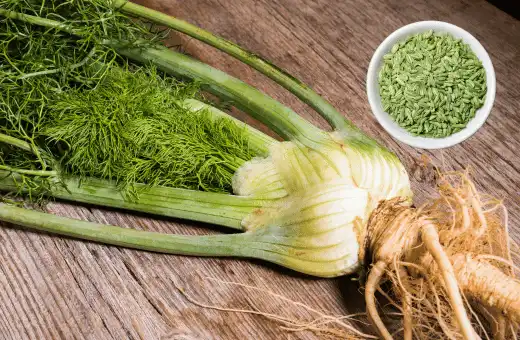
Fennel has a sweet, licorice-like flavor that can be used as an excellent celery substitute.
Ratio or measurement: Use one medium-sized fennel bulb to replace one cup of celery in your recipe.
Fennel works well in soups, salads and as a seasoning for meat dishes.
2. Bok Choy
Bok Choy is a great substitute for celery in stir-fried dishes due to its crunchy texture.
Ratio or measurement: One medium-sized bok choy can replace one cup of chopped celery.
You can also utilize it in soups or salads for a subtle celery flavor.
3. Try Celeriac to replace Celery
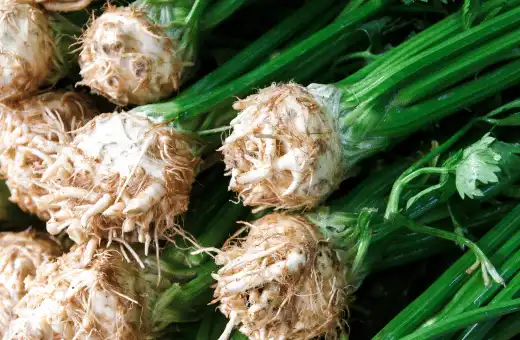
Celeriac, or celery root, is the perfect substitute for celery in any dish. This root vegetable has an identical texture and flavor profile as celery.
Ratio or measurement: One medium-sized celeriac can replace one cup of chopped celery.
Use it in soups, stews, and casseroles.
4. Jicama
Jicama, also understood as the Mexican turnip, is a crunchy root vegetable that can be used as a celery substitute in salads or as a snack.
Ratio or measurement: Use one medium-sized jicama to replace one cup of chopped celery.
Jicama has a slightly sweet and nutty flavor that complements well with other ingredients.
5. Leeks – alternative for Celery
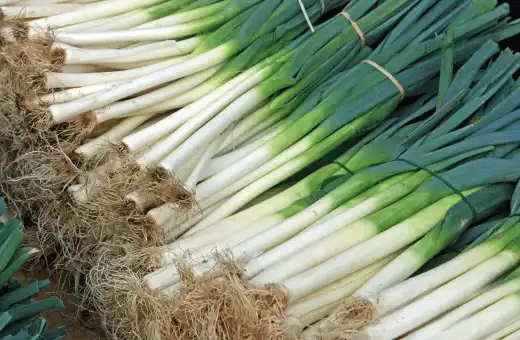
Leeks have a mild onion-like flavor and can use as a celery substitute in soups, stews, and casseroles.
Ratio or measurement: One medium-sized leek can replace one cup of chopped celery.
Use only the leek’s white and light green parts and chop them finely.
6. Asparagus
Asparagus has a slightly bitter flavor and a tender texture that works well in place of celery.
Ratio or measurement: Use one cup of chopped asparagus to replace one cup of chopped celery.
Asparagus can be used in soups, salads, and other dishes where celery is commonly used.
7. Green Bell Peppers taste like Celery
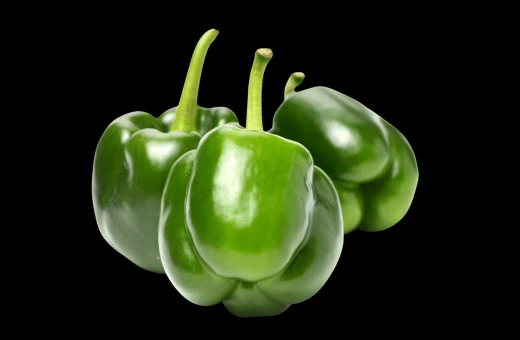
Bell peppers have a similar crunchy texture as celery but with a less intense flavor.
Ratio or measurement: Use one medium-sized green bell pepper to replace one cup of chopped celery.
Bell peppers work well in soups, stews, and casseroles.
8. Cucumber
Cucumber is a refreshing celery replacement that has a similar crunchy texture. Since it has a mild flavor, it won’t overpower your dish.
Ratio or measurement: The ratio of celery to cucumber is 1:1. Use it in salads, sandwiches, and even in soups.
9. Parsley – A good alternative for Celery
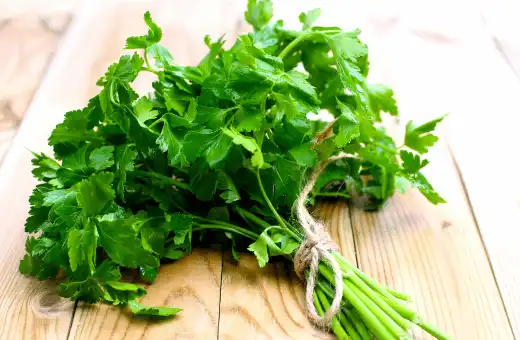
Parsley has a mild celery-like flavor and can replace celery in soups, stews, and sauces.
Ratio or measurement: The ratio of celery to parsley is 1:1. You can use both leaves and stems, making it an ideal substitute.
10. Zucchini
Zucchini has a slightly sweet taste and a soft texture that can be used as a celery substitute in casseroles, stir-fries, and soups.
Ratio or measurement: The ratio of celery to zucchini is 1:1. You can use raw and cooked it.
Substitute for celery in chicken soup
In chicken soup, three possible substitutes for celery are mushrooms, leeks, and carrots.
Mushrooms are a great replacement for adding a savory flavor to the soup; just ¼ cup of chopped mushrooms can do the trick.
Leeks add a mild onion-like flavor that can enhance the taste of the soup when added in small amounts.
Try using half a leek, diced small. Carrots add sweetness to the soup and provide color as well. About ⅓ cup of diced carrots will provide enough flavor without overpowering the other ingredients.
Each ingredient may need to be cooked differently depending on how much time you have – mushrooms may require more cooking time than leeks or carrots, for example.
For maximum flavor, sauté each vegetable separately with butter and salt before adding them to your soup.
This will help bring out their individual flavors as well as provide a nice base for all of your ingredients to cook together in one pot!
Substitute for celery in bolognese
Carrots, mushrooms, and bell peppers are all great substitutes for celery in bolognese.
Carrots can be used in the same 1:1 ratio as celery, while mushrooms and bell peppers should be used at a 2:1 ratio.
Carrots add a little touch of sweetness to the dish, while mushrooms bring a rich, umami flavor. Bell peppers add a slightly smoky flavor as well as a crunchy texture to the bolognese.
All three substitutes are packed with nutrients such as Vitamin A, Vitamin C, and fiber. Furthermore, they all contain antioxidants that help fight inflammation and free radicals.
Using these substitute ingredients in your bolognese will not only give it an extra boost of flavor but also make it healthier than using traditional celery.
Substitute for celery in a stew
One excellent substitute for celery in a stew is carrots. Carrots are sweeter than celery, and they work well to enhance the flavor of other vegetables, such as onions and potatoes.
To replace one cup of diced celery, use three-quarters of a cup of diced carrots. Carrots also provide an extra boost of vitamins A and C, creating them a healthier option.
Another great substitute for celery in a stew is mushrooms. Mushrooms have an earthy umami flavor that will add depth to your stew without overpowering the other flavors.
You can easily replace one cup of diced celery with one cup of sliced mushrooms. Additionally, mushrooms are high in B vitamins as well as antioxidants which can help boost immunity and fight inflammation.
A third substitute for celery in a stew is parsnips. Parsnips have a sweet taste similar to carrots but with a slightly nutty flavor.
To replace one cup of diced celery, use one cup of diced parsnips. They are also increased in Vitamin C and fiber, making them a nutritious addition to stews or soups.
Substitute for celery in the stuffing
A great substitute for celery in stuffing is leeks, mushrooms, and onions. Leeks provide a slightly milder flavor than celery and are just as crunchy.
One substitution you can use is to replace one cup of chopped celery with two-thirds of a cup of chopped leeks.
Mushrooms are a great option, too, as they add umami flavor and texture to stuffing. If using fresh mushrooms, chop them up into small pieces that are similar in size to the other vegetables, like onion and celery.
Substitute one cup of chopped celery with one-third of a cup of chopped mushrooms.
Onions work well as a substitute for celery in stuffing recipes since they have a similar taste and crunchy texture. To replace one cup of chopped celery, use half a cup of finely chopped onions instead.
Each ingredient will add its own unique flavor to your stuffing mixture, so it’s best to test the ratios until you get the desired taste that you’re looking for.
Substitute for celery flakes
One of the best substitutes for celery flakes is dried onion flakes. Dried onion flakes can be used in equal parts to replace celery flakes in a recipe, making it an easy one-for-one swap.
Not only do dried onion flakes offer a subtle flavor boost, but they are also loaded with beneficial nutrients like fiber, vitamin C, and potassium.
Another great substitute for celery flakes is dried garlic powder. While not quite as potent as fresh garlic, the dried version still provides plenty of flavors while being easier to work with.
To replace celery flakes in a recipe, use 1 teaspoon of garlic powder for every tablespoon of celery flakes needed.
Keep in mind that garlic powder will add more intense flavor than celery flakes, so start small and adjust according to taste.
A third option that works well as a replacement for celery flakes is dehydrated bell pepper pieces or dust.
Depending on the source used, the flavor may range from mild to slightly sweet and tangy, depending on their origin.
To replace celery flakes in a recipe, use 1 teaspoon per tablespoon required and add more if desired for added flavor complexity.
Dehydrated bell peppers are also rich in vitamins A and B6 which makes them an excellent addition nutritionally.
Substitute for celery in chicken salad
One of the best alternatives for celery in chicken salad is cucumber. Cucumbers have a mild, crunchy texture and flavor that can easily mimic the texture and flavor of celery.
Moreover, cucumbers are high in water content, so they help to keep chicken salad moist and flavorful.
The ratio of cucumber to celery can be 1:1 or slightly higher if desired – for example, 2 cups of diced cucumber per 1 cup of diced celery.
Another great substitute for celery in chicken salad is apples. Apples lend a sweet-tart flavor that complements the savory notes found in most chicken salads.
Additionally, their crisp texture helps to add crunchiness to the dish. For best results, use tart apples such as Granny Smiths; the ratio of diced apples to diced celery should be around 1:1.
Finally, bell peppers can also make an excellent substitute for celery in chicken salad. Bell peppers come in various colors and flavors (mild or sweet), so they can liven up a bowl of chicken salad.
Bell peppers provide crunchiness and sweetness without competing with the other flavors; when substituting them for celery, a ratio of 1 cup diced bell pepper per 1 cup diced celery works well.
Substitute for celery root
Celery root, also known as celeriac, is an underutilized root vegetable that is related to the celery plant.
It has a mild, nutty savor that works well in a variety of dishes. As a substitute for celery root, you can use turnips or parsnips.
Turnips are similar in appearance to celery root and have a slightly sweet and peppery taste. They can be cooked like celery root, including boiling, steaming, roasting and sautéing.
To substitute one cup of diced celery root, use three-quarters of a cup of diced turnip.
Parsnips are also good substitutes for celery root. Parsnips are long white taproots with slightly sweet and nutty flavors similar to carrots but with more earthy elements.
To substitute for one cup of chopped celery root, use one cup of chopped parsnips.
When substituting these vegetables for celery root, it’s important to adjust your cooking time accordingly since the vegetables have different textures and densities.
For example, parsnips may require a longer cooking time than turnips or celery roots.
Conclusion on substitute for celery
Whether it’s because you don’t like the taste of celery or you don’t have any in your pantry, these ten celery substitutes are great options to try.
Whether you’re using fennel for a sweet and anise flavor, bok choy for a crunchy texture, or asparagus for a slightly bitter taste, these substitutes will not disappoint.
Remember to use the ratios provided and experiment with these substitutes to find the perfect flavor for your dishes.
FAQs on substitute for celery
Q1. What vegetable is similar to celery?
Celery has many similarities to another leafy green vegetable, parsley. Both are lower in calories and high in dietary fiber, as well as rich sources of vitamin C, potassium, magnesium and folate. Parsley is slightly more nutritious than celery as it contains more iron, calcium and zinc.
Parsley has a stronger flavor than celery and can be used both raw and cooked. It can be easily added to soups or salads for extra crunch and flavor. Parsley also makes an excellent addition to pesto sauces, salsas or dips.
Q2. How much celery seed to substitute for celery?
Generally speaking, when substituting celery seed for celery in a recipe, you should use three times the amount of celery seed as the amount of celery is called for. For example, if a recipe wants 1 cup of chopped celery, then you should use 3 tablespoons of celery seed. Remember that utilizing too much or too little can alter the dish’s flavor significantly.
Additionally, you should consider whether the dish requires cooked or uncooked celery; some recipes may need to be modified, counting on whether you are using fresh, frozen, or dehydrated celery. If you require help with how much to use, start small and adjust according to taste.
Q3. Can celery seed substitute for celery salt?
Celery seed and celery salt are quite different ingredients, despite their similar-sounding names. While both can be used to season dishes, they have very different flavors and applications.
Celery seed is the small, round fruit of an herb in the parsley family, Apium graveolens. It has a gentle taste that is slightly bitter and herbaceous. It is most normally used to add flavor to brines, pickles, salads, soups, stews and sauces.
Conversely, celery salt is a blend of ground celery seed and regular table salt that provides an intense flavor profile. This combination of fine-grain sea salt with ground celery seed imparts a salty taste with an additional hint of umami flavor from the celery seed.
Celery salt is frequently used as a seasoning for savory dishes such as Bloody Marys as well as marinades and rubs for meats like chicken or pork chops.
So while it may be pleasing to use celery seed as a substitute for celery salt when flavoring food items, it should be noted that they are two different ingredients that provide very distinct flavors.
Celery seed cannot replace celery salt in recipes due to its milder flavor, but it can provide a unique taste to certain dishes when used strategically.
Q4. What herbs are similar to celery?
Similar herbs to celery include dill, parsley, and fennel. Dill is an herb with a mild flavor that is often used to flavor fish dishes; parsley is a green herb with a little sweet taste that can be used in salads or as a garnish; and fennel has a distinct licorice-like flavor and can be used as an aromatic when cooking.
All three of these herbs are similar to celery in that they all have similar colors, textures, and flavors. Additionally, all three can be eaten raw, cooked, or used as seasoning for other dishes. Celery itself is one of the most versatile vegetables around and can be found in many types of cuisine from around the world.
It contains vitamins A, B6, C, K, calcium, magnesium, and iron making it highly nutritious. The crunchy texture and mild flavor make it a great addition to salads or soups, while its long stalks make it perfect for adding character to sandwiches and wraps.
Q5. What seasoning is most like celery?
Celery has a mild, slightly sweet flavor that can be compared to various other seasonings used in cooking. Asafoetida is one seasoning that has a very similar flavor and aroma to celery. It’s often referred to as a “celery seed substitute”. Cumin is another seasoning that has a similar taste and smell to celery, with deeper, earthier tones than fresh vegetables.
Coriander and caraway are also excellent substitutes for celery in recipes because they have a similar flavor profile but are more aromatic than celery itself. Finally, bay leaves can provide the same hint of the herbaceousness that celery provides but in a less concentrated form.

